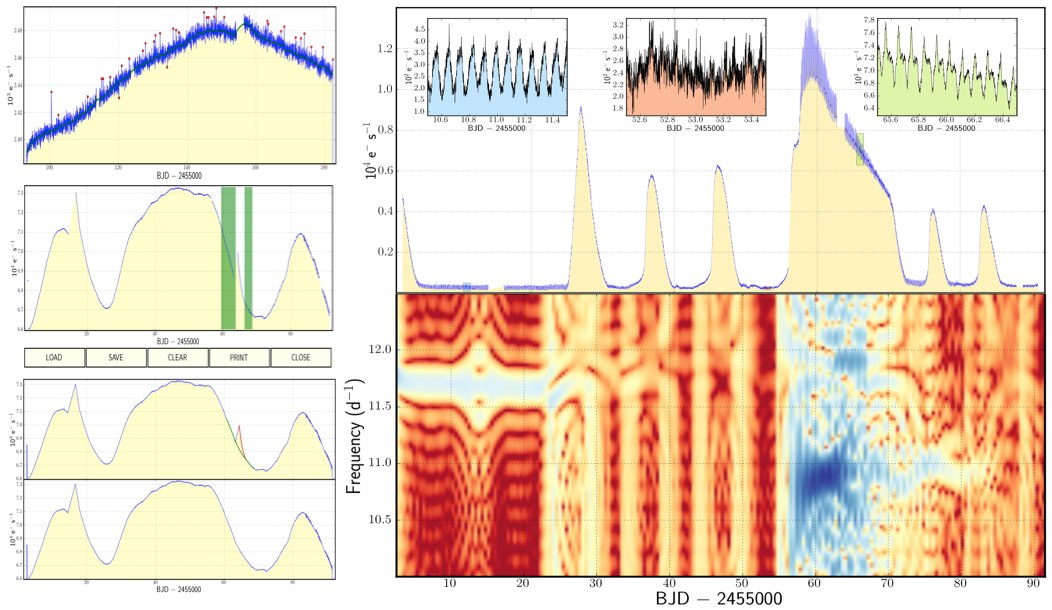|
|
|
||

| |||
| Data Inspection and Analysis Tools | |||
|
Kepler data is encoded using the Flexible Image Transport System (FITS). General FITS documentation is maintained by the Office for Guest Investigator Programs (OGIP) FITS Support Office at NASA GSFC. A primer on the FITS format can be found here. Each Kepler FITS product contains a combination of header keywords containing scalar data, time-dependent data stored as tables and/or detector pixel-level data stored as two-dimensional images. The content and format of each file are defined in the Kepler Archive Manual. DATA VISUALIZATION A variety of free software exists for FITS data inspection. While by know means a complete list, we have found the tools listed here to be of most common employment in our own inspection of the Kepler data:
DATA REDUCTION
DATA ANALYSIS
Here we provide links to publicly available software that may be useful to GOs and archive users for the interpretation of photometric time series. We invite users and developers to suggest more resources to add to this list. PERIOD04:
Period04 is designed for the statistical analysis of large
astronomical time series. Developed by
Patrick Lenz and Michel Breger
at the University of Vienna, Period04 supports the Theory and Observation of Pulsating Stars
(TOPS) Group. This software contains tools to
identity power within time series and perform
multi-frequency fitting. Period04 is a hybrid Java/C++ program. Execution requires
the Java Runtime Environment (JRE) on your local machine. JRE is pre-installed on MacOS X
platforms, Windows and Linux options are also available. AMP:
The Asteroseismic Modeling Portal is an interface maintained by the National Center for
Atmospheric Research (NCAR). AMP provides astronomers access to the software and resources
needed for computationally intense research in stellar seismology. In particular, tools
are available for astronomers wanting to utilize the Aarhus Stellar Evolution Code, coupled
with a parallel genetic algorithm to derive the properties of Sun-like stars from observations
of their pulsation frequencies. Users can (a), submit a list of measured properties and
determine the best-fitting stellar model, or (b), specify a set of stellar parameters,
and execute evolutionary models. Much of the motivation for development of AMP is the large increase in asteroseismic
data now being delivered by Kepler.
AMP represents an effort to develop a robust stellar
model-fitting pipeline for asteroseismic data. FAMIAS:
An acronym for Frequency and Mode Identification for Asteroseismology, FAMIAS is a suite of
software tools for the analysis of photometric and spectroscopic time series data. This
software is provided by the European Coordination Action in Helio- and Asteroseismology
(HELAS).
Two main sets of tools are contained within FAMIAS. The first set allows users to
search for periodicities in their data using Fourier and non-linear least-squares fitting
algorithms. The other set can be used to identify modes for the detected pulsation
frequencies, and determine their pulsation quantum numbers. FAMIAS tools are applicable to all pulsating main-sequence stars with T(eff) > 5500 K. FAMIAS can be implemented on Linux and MacOS X platforms. PHOEBE:
An acronym for PHysics Of Eclipsing BinariEs, PHOEBE is
a software package designed for the modeling of eclipsing binary stars, combining observed
photometric and spectroscopic data. PHOEBE contains a core library of functions, models, and
problem solvers, accessed through either a user interface or a terminal-window
scripting program. Its functionality enables users to combine a variety of techniques to constrain the physical properties of the modeled system with minimal
technical effort. This software can be installed on various flavors of
LINUX, MacOS, Windows XP and Vista.
TAP and autoKep:
An IDL package designed for the analysis of extrasolar planet (ESP) transit light curves.
The Transit Analysis Package (TAP) software utilizes Markov Chain Monte Carlo (MCMC) techniques to fit transit light curves using the Mandel & Agol (2002) model. The software is able to simultaneously analyze multiple transits observed in different conditions (instrument, filter, weather, etc). The graphical interface allows for the simple execution and interpretation of Bayesian MCMC analysis tailored to a user’s specific data set and has been thoroughly tested on ground-based and Kepler photometry. The autoKep IDL GUI is designed to provide streamlined transit light curves from MAST Kepler archive fits files.
FITS LIBRARIES
Scripting languages provide both FITS I/O libraries and data processing algorithms, allowing users to develop their own data analysis scripts for Kepler data. An extensive list of FITS I/O libraries is maintained by the FITS Support Office at NASA Goddard Space Flight Center. We list below those that we in the GO Office have familiarity with and can provide a degree of support. PyFITS: Python is a freeware scripting language available for Unix, Linux, Mac OS and Windows platforms. PyFITS is an external python library that provides an interface to FITS formatted files. PyFITS is developed by the Science Software Branch at the Space Telescope Science Institute as support for their PyRAF development. PyRAF allows Python scripters to use the full functionality of IRAF libraries within the more powerful framework of Python. This will be the software environment for James Webb Space Telescope data reduction. CFITSIO: NASA's High Energy Astrophysics Science Archive Research Center provides a library of algorithms for FITS I/O. Download instructions and programmers guide can be found at the HEASARC software pages. Originally written for C and FORTRAN programmers, there are now many interfaces provided for download that provide libraries for C++, C-sharp, Perl, Tcl, Python, Ruby, S-lang, Matlab and Labview. |
Questions concerning Kepler's science opportunities and open programs, public archive or community tools? Contact us via the email address.



